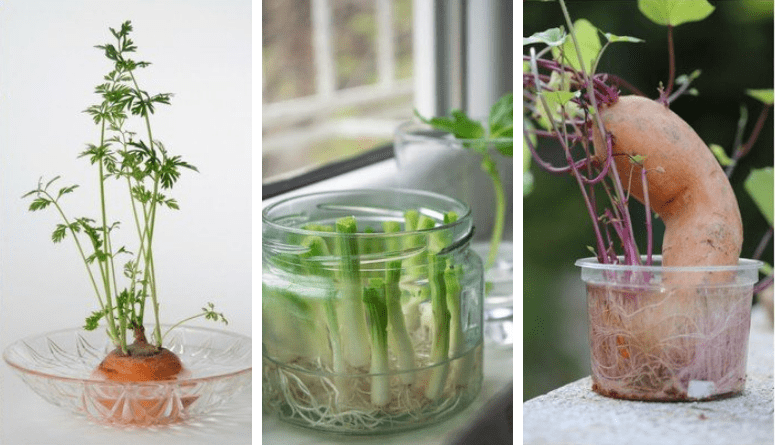
Sure, you’ve heard that buying organic food over the genetically modified or pesticide exposed versions is ideal for your health, but it can get costly.
Due to the limited supply of organic foods as well as the additional labor and maintenance required to produce them, you may be paying 20-100% more for an organic banana!
Fortunately, here are 20 vegetables and herbs you can grow indoors using parts of the produce you would throw away anyways, and this can save you a pretty penny the next time you go grocery shopping.
Romaine Lettuce
Similar to celery, keep the base of your romaine lettuce in a bowl with a ½ inch of warm water. Leave it to sit in direct sunlight, and in a week or two, your lettuce stem will produce fresh, new lettuce leaves for all your great salads.
Transplant your lettuce to soil to continue growing. They should be full grown in three to four weeks. This process works for Bok Choy as well.
Garlic Sprouts
Are those tentacles?! Nope, those long green things growing out your garlic are green shoots. You can put them in a little water, under a lot of sunlight and grow a bunch of garlic sprouts.
They are milder in taste than garlic cloves and are great in salads, pasta and as a garnish.
Carrots
Place chopped off carrot tops in a container filled with a bit of water. Pretty soon, they will begin to sprout delicious greens from the top that are a nice addition to meals.
Using a deeper contain and more water, use toothpicks to keep carrots halfway in the water and wait for them to root. Once they root, you can plant them in your garden for a continuous supply!
Turnip
Like carrots, cut off turnip tops and leave them in a shallow container with water until they begin growing roots. This can take a couple of weeks. Once they’ve sprouted, plant them outside the same way you would your carrots!
Sweet potato
Unlike most vegetables, sweet potatoes aren’t started by seed but by slips (or shoots). Clean and cut a sweet potato in half, then place it half in/half out of a jar full of water using toothpicks.
Over a few days, your sweet potato will begin to sprout slips at which point you remove them and place them in water to grow roots.
You should have rooted slips with the week. Next, plant them in loose, well-drained soil and water every day in the first week, and then every other day (or as needed) the following weeks.
Ginger
With ginger you already have, look for pieces that already have little things growing out of them. With that piece, cut off the parts that look like they’re about to start what’s called a “rhizome” because they’re the key to growing new ginger plants.
Growing this food takes minimal effort but does require the right conditions. Warm, slightly humid places like kitchens are perfect. Plant the piece of ginger about 3-5 inches in the soil with its rhizome pointing upwards. Water it regularly.
It’s a labor of love and can take up to ten months before you get a sufficient amount of ginger, but its health benefits are more than worth it.
Pineapple
This will definitely take a few years but if you’ve got the time and right climate, why not try? Take a pineapple and cut the flowery “crown” off about an inch below the leaves.
Trim around the bottom until you see little brownish bumps (these are the root buds). Before planting, dehydrate the pineapple crown to prevent rotting too soon.
Now, with your prepped pineapple cutting, place it in a shallow container of warm water. When the cutting begins to root, replant it into a container with soil and be sure to water once a week. If possible, keep it in a bright, warm place with as much direct sunlight as possible.
Rosemary
Like other herbs, you can regrow rosemary from 5-6 inch cuttings. Place them in water and within a few weeks, there should be enough that have rooted and not rotted. In a 4″ pot filled with damp potting soil, make a 3″ hole with a pen or pencil and place the rosemary cutting gently into it.
Because this herb is so delicate, only water it when the soil starts feeling dry. Keep it direct sunlight for 6-8 hours per day because it needs light to flourish. If the soil isn’t dry yet, giving them a quick mist is also okay.
Potatoes
When growing potatoes, you need ones with ‘eyes’ (or slips) growing on it. When you’ve got a potato with a lot of eyes, cut it into 2 inch squares with each piece having a couple of eyes.
Leave them out in room temperature for a couple of days to let them dry out to help prevent rotting. In a deep pot, place the cubes 8″ deep with the eyes facing upwards and cover it with another 4″ of soil.
As more roots begin to grow, continuously add more soil and keep modestly watered. In as little as 70 days, you should have quite a few potatoes!
Tomatoes
You can regrow new tomato plants that can reach up to 8” feet. Ease the tomato plant out of its pot, trim the low leaves, and place it in a hole, fill it with soil, and do not compress it much.
Celery
To grow this healthy snack at home, cut off the base of the celery and leave it in a bowl with a little bit of warm water. Keep the bowl in direct sunlight, and in a week, your celery base will start to grow leaves. Transplant the celery in soil and watch it grow!
Cabbage
Don’t throw away the bottom of your cabbage head just yet. Just like celery, leave it in a container with an inch or two of water in a well-lit area and wait. Over time, it will start to regrow with no planting required.
Avocado
You can successfully grow an avocado tree from just one avocado pit.
Mint
To grow mint, get a clipping and plant it 3″ deep in a 5-8″ pot of damp soil. Make sure your mint plant is in a slightly humid, sun-exposed room (the kitchen is ideal).
Every few days, to allow for the plant to grow evenly, rotate the pot. Within a few weeks, your mint plant should begin to flourish and be ready to be plucked for delicious dishes and drinks.
Lemon
To grow a lemon tree at home, you will need an organic lemon with non-germinating seeds, nutrient-rich potting soil, a planting pot that’s 6″ wide and 6″ deep, a seedling pot that’s 24″ wide and 12″ deep, and a sunny growing location (possibly with a grow lamp).
Leeks
Similar to green onions, leeks can be regrown by placing the roots in water and exposing them to sunlight.
Peppers
You can grow a number of hot peppers from the seeds that are leftover. Just collect the seeds from your habaneros, jalapenos or any other peppers that you have on hand.
Plant them in potting soil and keep in direct sunlight unless it is warm outside and then you can just plant them in your garden area. Peppers grow relatively fast and don’t require a lot of care. Once you get a new crop, just save some of the seeds for replanting again.
Scallion
You can regrow scallion, (green onions,) in as little as five days. Simply leave at least an inch attached to the roots of your left over scallion, put them in a small glass of water, topping up the water if it evaporates. Your scallions will flourish.
Basil
Got some basil clippings lying around? If they have at least four-inch stems, gather them up and put them in a glass of water under direct sunlight. When the stems grow two inches long, you can put them in some soil in a pot and grow your very own basil plant. No more basil shopping for you!
Onions
Unlike the other foods on this list, onions have to go directly in the soil to grow. Take the bottom end of the onion and plant it in a pot or directly in the soil outside. If it’s potted, water it when needed. The more of a bottom you leave on the onion, the better. At three weeks, the onion will develop roots. By the fourth week. It will sprout leaves.
As you can see, most of the procedures follow similar methods: a container of water and direct sunlight. Each process is fairly easy, saves you a lot of money and ensures that you are putting fresh, organic food in your body.





